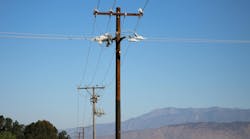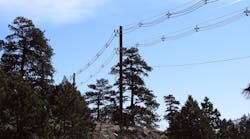Most wildfires result from nature, such as lightning strikes or human activity, including unattended campfires and arson. Yet, according to the National Interagency Fire Center, 5% of wildfires in the U.S. are caused by electric utility infrastructure, such as power lines, downed poles and transformers, often with tragic losses of life and property.
In 2023, while Canada experienced a severe and intense wildfire season, a quiet season in the U.S. was marred by the country's deadliest wildfire in over a century on Maui. Hawaiian Electric Co. Inc. acknowledged its power lines started the fire, which claimed 115 lives.
Communities and government authorities expect electric utilities to reduce the risk of wildfires caused by their infrastructure and operations. In June 2023, an Oregon jury found PacifiCorp responsible for causing wildfires during Labor Day weekend in 2020, ordering the utility to pay tens of millions of dollars to 17 homeowners who sued and finding it liable for broader damages that could push the total award into the billions.
On March 7, 2024, Xcel Energy Inc., the parent of Southwestern Public Service Co., issued a statement acknowledging “that its facilities appear to have been involved in an ignition of the Smokehouse Creek fire.”
Fire Prevention Efforts
In the face of increasing climate-related wildfires, utilities have taken steps and made significant financial investments to reduce risk. Pacific Gas and Electric Co. increased its investment in wildfire mitigation by US$2 billion over the last five years.
Many utilities, especially those in the western U.S., have developed comprehensive wildfire plans in conjunction with state and federal fire agencies that include the following actions:
- Conducting regular inspections and replacing damaged or outdated equipment
- Implementing fire-resistant design and materials, such as steel or concrete poles and underground cables.
- Monitoring and controlling vegetation near power lines.
- Deploying innovative grid technologies and sensors for monitoring and control.
- Coordinating with fire agencies and emergency responders to prevent and respond to wildfires, such as sharing power system information and risk assessments. The U.S. Department of Energy’s Grid Resilience Innovation Partnerships (GRIP) program also is lending a hand. In 2023, the department announced grants of $662.5 million for 13 projects — approximately one-quarter of all awards — implementing wildfire mitigation strategies. With utilities matching these awards, the total investment will be $1.26 billion.
Enhanced Awareness And Planning
Today, utilities seek sensor technology to locate faults and cost-effectively monitor real-time pole and line conditions, such as vegetation contact and line slapping. Current systems monitor specific sections and operations of the grid but must deliver cohesive, end-to-end awareness.
A new generation of sensing technology, bolstered by advanced data analytics, is needed to augment wildfire mitigation efforts and planning. Considerations such as communications and connectivity, power and weather resistance are essential to creating a network of intelligent devices that can provide real-time awareness. These platforms must integrate into utility management systems, providing data that can be analyzed to provide trends, patterns, predictions and visualization.
Smart, Connected And Aware
LTE- and GPS-enabled pole-tilt, vibration and impact sensors can provide vital information, including vegetation issues and line slapping. Pole monitoring also can spot and locate poles that have been damaged or need repair to prevent downed lines and fires. These same monitors also can be attached to trees to augment vegetation management. Including cameras with tilt and vibration monitors adds an additional layer of awareness.
Connected air-quality monitors can detect smoke in high fire-threat areas. Even lighting-control devices on streetlights can provide information such as momentary voltage sags that can be a symptom of vegetation touching power lines. They also can send tilt and vibration alerts.
Connecting and monitoring distribution transformers, especially in high-risk areas, enables utilities to detect momentary faults caused by vegetation overgrowth, downed poles, sparking from line failure, arcing, overheating and power surges.
Data-Driven Decision-Making
While sensor technology provides real-time data, creating actionable insights requires integrating it, turning it into usable information and synthesizing it into trends, patterns and models. Imagine a heat map of transformers and poles in selected high-risk areas with fire potential based on overload conditions, pole placement, vegetation and weather.
Making these insights and predictions possible requires artificial intelligence (AI), specifically machine learning (ML). ML is the glue that uses algorithms to tie together all the data points across different sensors, pinpointing locations needing attention. They can help utilities to find the so-called needle in the haystack and guide expert maintenance teams to specific and actionable situations, so dangerous events can be avoided or mitigated before they happen. ML constantly learns through more data and experience, improving its modeling and decision-making.
ML enables what-if scenario planning, using weather and historical data to predict conditions where utility infrastructure may cause a fire. Algorithms can further advance this knowledge with models for more accurate alert thresholds and patterns.
Integrating these valuable insights with existing supervisory control and data acquisition, outage management system and other utility platforms is critical, as is the ability to share selected information with authorities and customers in real time, further enabling utilities to be at the forefront of emergency responses. The good news is much of the sensor technology exists or is being developed, and data scientists are working to improve the ML platforms needed to create game-changing insights. Not surprisingly, AI is also an active team member in development efforts.
Fostering Collaborative Solutions
Climate change and droughts mean wildfires will remain a constant threat. While utilities cannot do much about the weather or human behavior, their work with communities and fire agencies can mitigate wildfire risk caused by their infrastructure. Smart-connected sensors, real-time data and machine learning can provide the insights utilities need to continually improve their wildfire planning and make faster decisions in a crisis.
In tandem with federal, state and local partnerships, these same insights can help utilities to reduce the risk of wildfire, save lives and property, and ensure the communities they serve have safe and reliable electricity.
Charlie Nobles is vice president, smart grid-utilities at Ubicquia Inc.


